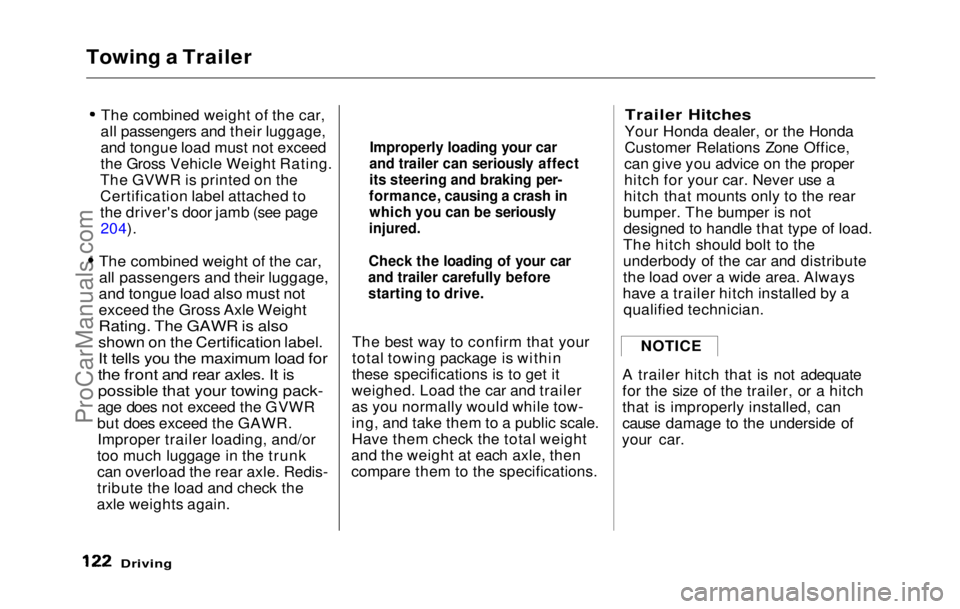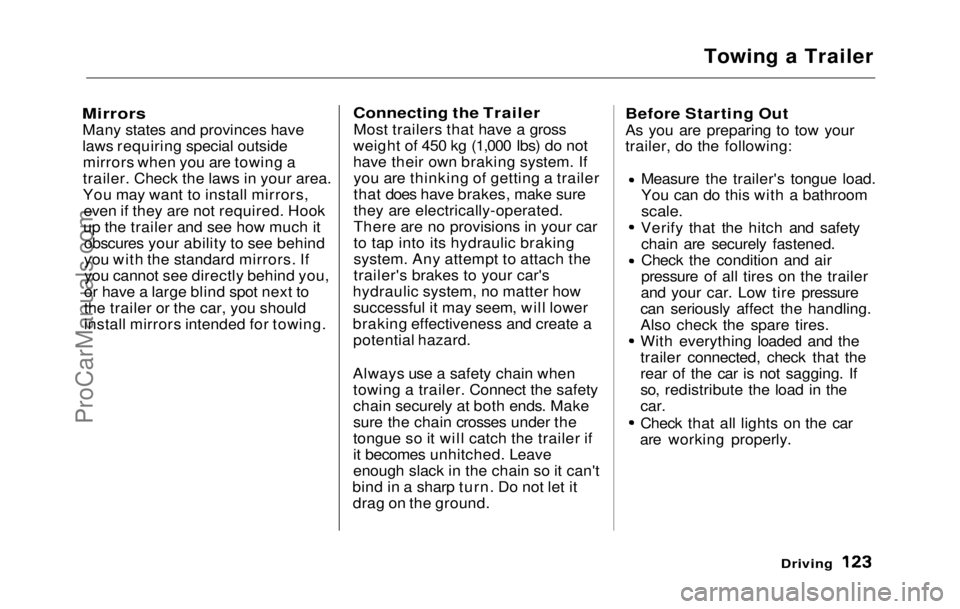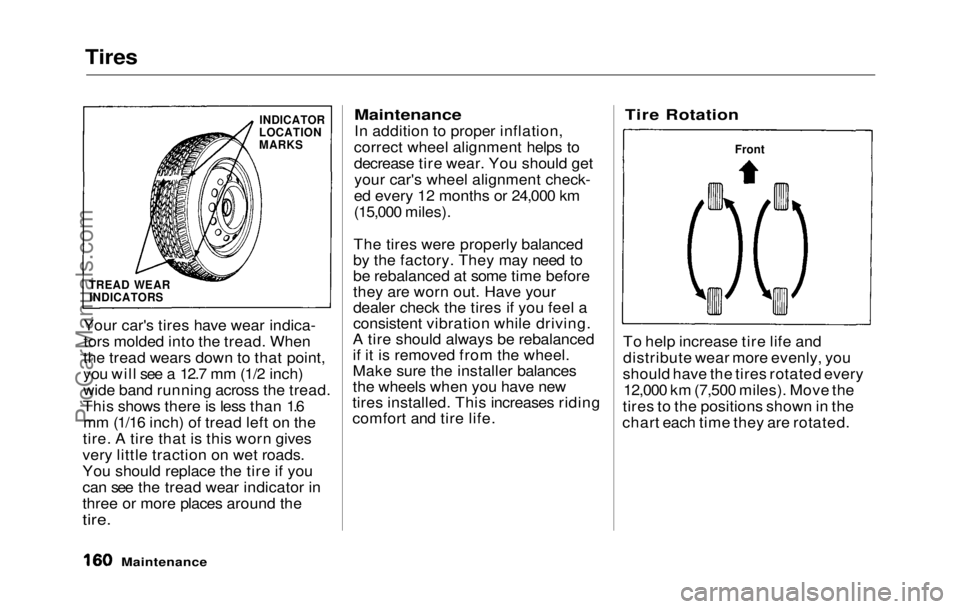Page 121 of 225

Towing a Trailer
The combined weight of the car,
all passengers and their luggage,
and tongue load must not exceed
the Gross Vehicle Weight Rating.
The GVWR is printed on the
Certification label attached to
the driver's door jamb (see page 204).
The combined weight of the car,
all passengers and their luggage,
and tongue load also must not
exceed the Gross Axle Weight
Rating. The GAWR is
also
shown on the Certification label.
It tell
s
you the maximum load for
the front and rear axles. It is
possible that your towing pack-
age does not exceed the GVWR
but does exceed the GAWR. Improper trailer loading, and/or
too much luggage in the trunk
can overload the rear axle. Redis-
tribute the load and check the
axle weights again. The best way to confirm that your
total towing package is within
these specifications is to get it
weighed. Load the car and trailer
as you normally would while tow-
ing, and take them to a public scale.
Have them check the total weight
and the weight at each axle, then
compare them to the specifications.
Trailer Hitches
Your Honda dealer, or the Honda
Customer Relations Zone Office,
can give you advice on the proper
hitch for your car. Never use a
hitch that mounts only to the rear
bumper. The bumper is not
designed to handle that type of load.
The hitch should bolt to the
underbody of the car and distribute
the load over a wide area. Always
have a trailer hitch installed by a qualified technician.
A trailer hitch that is not adequate
for the size of the trailer, or a hitch
that is improperly installed, can
cause damage to the underside of
your car.
Driving
Improperly loading your car
and trailer can seriously affect
its steering and braking per-
formance, causing a crash in which you can be seriously
injured.
Check the loading of your car
and trailer carefully before
starting to drive.
NOTICEProCarManuals.comMain Menu Table of Contents s t
Page 122 of 225

Towing a Trailer
Mirrors
Many states and provinces have
laws requiring special outsidemirrors when you are towing a
trailer. Check the laws in your area.
You may want to install mirrors, even if they are not required. Hook
up the trailer and see how much it obscures your ability to see behind
you with the standard mirrors. Ifyou cannot see directly behind you,
or have a large blind spot next to
the trailer or the car, you should
install mirrors intended for towing.
Connecting the Trailer
Most trailers that have a gross
weight of 450 kg (1,000 Ibs) do not
have their own braking system. If you are thinking of getting a trailer
that does have brakes, make sure
they are electrically-operated.
There are no provisions in your car
to tap into its hydraulic braking
system. Any attempt to attach the
trailer's brakes to your car's
hydraulic system, no matter how successful it may seem, will lower
braking effectiveness and create a potential hazard.
Always use a safety chain when towing a trailer. Connect the safety
chain securely at both ends. Make
sure the chain crosses under the
tongue so it will catch the trailer if
it becomes unhitched. Leave
enough slack in the chain so it can't
bind in a sharp turn. Do not let it drag on the ground.
Before Starting Out
As you are preparing to tow your
trailer, do the following:
Measure the trailer's tongue load.
You can do this with a bathroom
scale.
Verify that the hitch and safety chain are securely fastened.
Check the condition and air
pressure of all tires on the trailer
and your car. Low tire pressure
can seriously affect the handling.
Also check the spare tires.
With everything loaded and the
trailer connected, check that the
rear of the car is not sagging. If
so, redistribute the load in the
car.
Check that all lights on the car
are working properly.
DrivingProCarManuals.comMain Menu Table of Contents s t
Page 158 of 225

Tires
Your car's tires have wear indica-
tors molded into the tread. When
the tread wears down to that point,
you will see a 12.7 mm (1/2 inch)
wide band running across the tread.
This shows there is less than 1.6 mm (1/16 inch) of tread left on the
tire. A tire that is this worn gives
very little traction on wet roads.
You should replace the tire if you
can see the tread wear indicator in
three or more places around the
tire.
Maintenance
In additio n
to proper inflation,
correct wheel alignment helps to
decrease tire wear. You should get your car's wheel alignment check-
ed every 12 months or 24,000 km
(15,000 miles).
The tires were properly balanced
by the factory. They may need to
be rebalanced at some time before
they are worn out. Have your
dealer check the tires if you feel a
consistent vibration while driving.
A tire should always be rebalanced
if it is removed from the wheel.
Make sure the installer balances
the wheels when you have new
tires installed. This increases riding
comfort and tire life.
Tire Rotation
To help increase tire life and
distribute wear more evenly, you
should have the tires rotated every 12,000 km (7,500 miles). Move the
tires to the positions shown in the
chart each time they are rotated.
Maintenance
INDICATOR
LOCATION
MARKS
TREAD WEAR INDICATORS FrontProCarManuals.comMain Menu Table of Contents s t